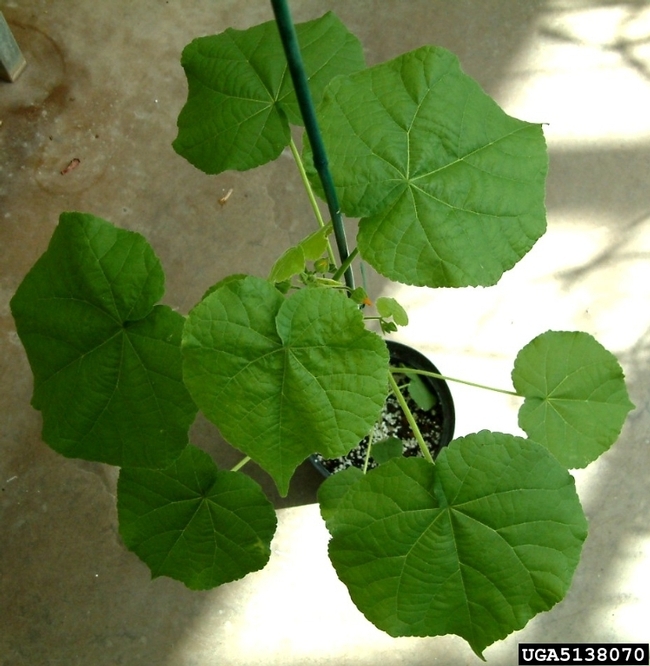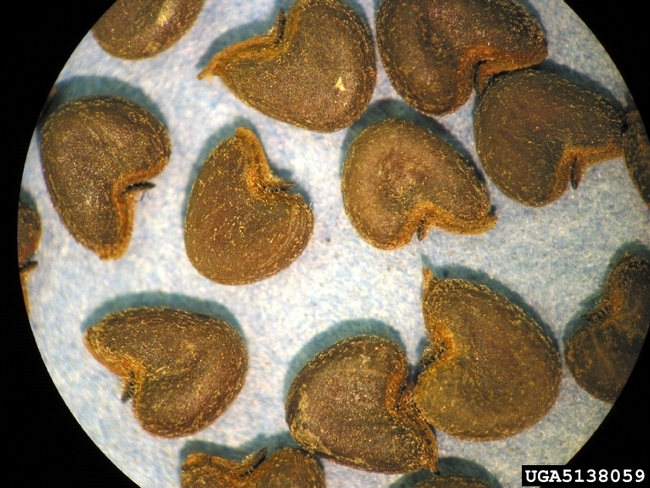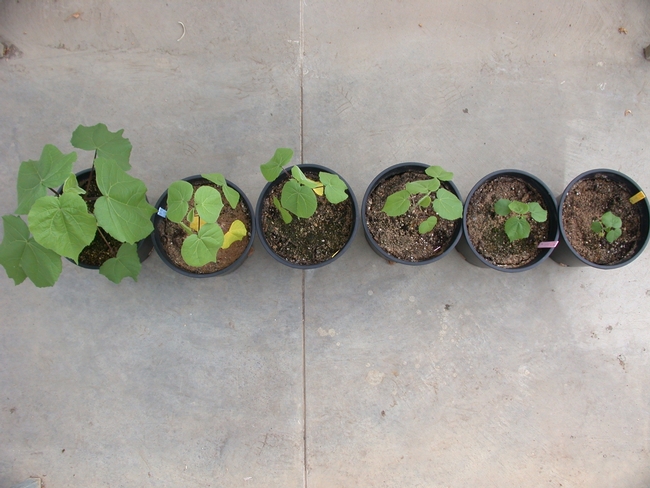Introduction to the species: Abutilon theophrasti (commonly known as velvetleaf) is a summer annual weed native to Asia. For those not familiar with the species, plants are tall (to 1-2 m) and erect with green- or purple-colored stems that branch at higher leaf axils (Warwick and Black 1988). The leaves are heart-shaped and covered in soft hairs (hence the name 'velvetleaf') (Warwick and Black 1988). Pale yellow- to yellow-orange-colored flowers are borne singly in the axils of leaves or in small clusters on short branches in the plant canopy (Warwick and Black 1988). Seed capsules are cup-shaped, hairy and either brown- or yellow-colored (Warwick and Black 1986, Kurokawa et al. 2003). Individual seeds are kidney-shaped and grey to black in color (Warwick and Black 1986). For a more detailed description of the species, visit the UC IPM plant profile.
Figure 1. Velvetleaf leaves (heart-shaped, toothed and hairy). Flowers can be observed in the leaf axils.
Figure 2. Velvetleaf seed under magnification.
Velvetleaf as a fiber crop: Velvetleaf was domesticated in central China, where the stem fibers were used to produce paper, sacking, netting, and coarse cloth, or were blended with silk to make satin and brocades (Dempsey 1975, Spencer 1984). It has been suggested that A. theophrasti was introduced to colonial America as a fiber source for the manufacture of cordage, twine and other necessities (Dempsey 1975, Spencer 1984). By the late 1700's, the species was widespread across the eastern seaboard of the United States; as of September 2013, the USDA PLANTS database indicated that velvetleaf has become naturalized in the 48 contiguous states and 9 Canadian provinces. In California, velvetleaf is common to the Central Valley, (predominantly, the Sacramento Valley) although it can be found in urban environments and disturbed areas that receive irrigation.
Studying the differences in growth and development of velvetleaf: In 2003, John Cardina's lab (Ohio State) conducted a study to characterize the morphological and phenological variation present in velvetleaf accessions from Asia, Japan, India, Europe, Eastern Africa and North America. Velvetleaf seeds (80 accessions from 21 countries) were obtained from Dr. R.N. Andersen (USDA-ARS, retired) and the U.S. National Plant Germplasm System (NPGS) (NPGS samples used in our study were originally collected by the N.I. Vavilov Institute of Plant Industry between 1916 and 1940. Kurokawa et al. 2003). Replicate samples from each accession (a minimum of 5 to 7 plants, each derived from a different parent) were grown in a greenhouse at the Ohio Agricultural Research and Development Center (OARDC) in Wooster, OH. Some of the attributes that were evaluated included: stem height (mm) at 4, 7 and 10 weeks; number of days from sowing to flowering; stem height (mm) at flowering; duration of flowering (days); number of days from sowing to harvest; final height (cm) at harvest; number of nodes at harvest; number of capsules (seed pods) per plant at harvest; and capsule color.
Figure 3. An example of differences among velvetleaf accessions with respect to growth rate.
Crop and weedy forms of velvetleaf can distinguished from each other: Results from our study indicate that accessions producing yellow-colored capsules differed significantly from those possessing brown-colored capsules. In general, plants with yellow seedpods were 1) taller, 2) flowered later and for a shorter period of time, 3) and produced fewer seedpods per plant as compared to plants producing brown capsules. Our results are in agreement with Kurokawa et al. (2003) who reported that the NPGS accessions could be divided into two forms (“crop” and “weedy”) based on a comparison of their morphological and phenological characteristics. According to Kurokawa et al.(2003), crop forms (which were primarily collected from Africa, Asia and India) 1) possessed yellow-colored seed capsules, and 2) were taller at all observation dates, 3) were minimally branched, and 4) had a longer vegetative phase than their weedy counterparts. Weedy accessions (which were typical of Europe and the US) were shorter, more branched, and produced greater numbers of non-dormant seeds in brown seedpods (Kurokawa et al. 2003).
The differences among the crop and weedy forms suggests that they have been subjected to different selection pressures. An upright, minimally branched form of velvetleaf would allow for the easier harvest of stem fibers (Kurokawa et al. 2003). Velvetleaf appears to be determinant with respect to growth; an increase in the duration of the vegetative phase would result in greater stem height, which is directly related to fiber yield (Kurokawa et al. 2003). A rapid transition between the vegetative and reproductive phases could be an advantage for the weedy velvetleaf, as this allows for increased reproduction potential (Baker 1974, Patterson 1985). Increased branching is associated with increased capsule production because A.theophrasti flowers are produced on short branches that develop from leaf axils in the canopy of the plant (Warwick and Black 1988). Kurokawa et al. 2003) speculated that the yellow capsule color, which is a recessive trait, may have served as a tool for preventing genetic contamination from the weedy forms.
Citations
Baker, H.G. 1974. The evolution of weeds. Annual Review of Ecology and Systematics 5:1-24.
Dempsey, J.M. 1975. Fiber Crops. University of Florida Press. Gainsville, Florida.
Kurokawa, S., N. Shimizu, S. Uozumi, and Y. Yoshimura. 2003. Intra-specific variation in morphological characteristics and growth habitat of newly and accidentally introduced velvetleaf (Abutilon theophrasti Medic.) into Japan. Weed Biology and Management 3:28-36.
Patterson, D.T. 1985. Comparative ecophysiology of weeds and crops: Pages. 101–130. In S. O. Duke, ed. Weed Ecophysiology. Volume. 1 Reproduction and Ecophysiology. CRC Press. Boca Raton, FL.
Warwick, S.I., and L.D. Black. 1988. The biology of Canadian weeds. 90. Abutilon theophrasti. Canadian Journal of Plant Science 68:1069-1085.


